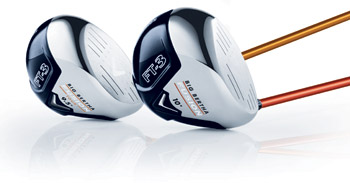 Callaway Golf is enjoying a resurgent 2005 after a couple off-years. The company started the year by launching the Big Bertha 454 Titanium driver, which has been a success in the marketplace. With the golf season in full swing across the U.S., Callaway has released a new titanium-composite driver, the Big Bertha Fusion FT-3. Will the company’s new driver succeed where the composite-based C4 and ERC Fusion drivers faltered? The early word is a resounding “Yes.”
Callaway Golf is enjoying a resurgent 2005 after a couple off-years. The company started the year by launching the Big Bertha 454 Titanium driver, which has been a success in the marketplace. With the golf season in full swing across the U.S., Callaway has released a new titanium-composite driver, the Big Bertha Fusion FT-3. Will the company’s new driver succeed where the composite-based C4 and ERC Fusion drivers faltered? The early word is a resounding “Yes.”
A quick recap of Callaway’s last three flagship drivers is in order to understand how the FT-3 came to be. After years in development, the company brought the Big Bertha C4 driver to the market in 2001. The driver had a 360cc head that was, with the exception of an aluminum soleplate and internal tungsten weights, made entirely of carbon composite. The club looked cool and was extremely forgiving. But it was a bit too cutting-edge for the public, who stayed away from the driver due to its muted sound and light feel. Two years later, the ERC Fusion driver arrived with a titanium face and a composite body, at approximately the same size and using the same internal weight distribution as the C4. The titanium face helped improve the sound, but the ERC Fusion was still not the resounding success at retail that Callaway expected.
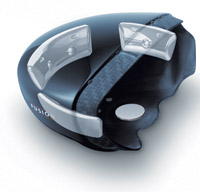 Fast forward to the present day. The Big Bertha Fusion FT-3 driver has finally made it to retail after nearly a year of testing on the world’s professional tours (where a smaller FT-2 model was tested and not put into prodution). The club has been used to win
Fast forward to the present day. The Big Bertha Fusion FT-3 driver has finally made it to retail after nearly a year of testing on the world’s professional tours (where a smaller FT-2 model was tested and not put into prodution). The club has been used to win four five major championships in the hands of players like Michael Campbell, Annika Sorenstam, and Phil Mickelson, who cited the driver as one reason he switched to Callaway from Titleist last season. Aside from big-time pro tour momentum, how is FT-3 different from its predecessors?
Construction
The FT-3 shares the basic design intent of the ERC Fusion: combine a hot titanium face with a lightweight carbon composite body, and use the saved weight to redistribute mass to key areas of the clubhead. As with the previous Fusion driver, the titanium cup face is connected to the composite body with heavy-duty epoxy. But there are some important differences in how the FT-3 is put together.
First, the head is much larger. The FT-3 is the first Callaway driver to hit the USGA/R&A limitation of 460cc. This serves to increase the moment of inertia (MOI) to make the club more forgiving on off-center hits.
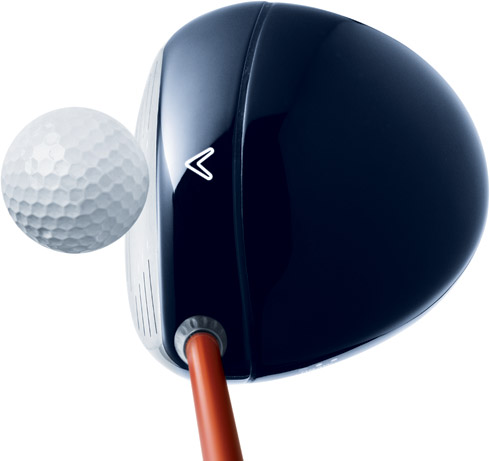
The FT-3 is an intimidating driver to look at at address. That (non-marked Callaway) ball is about to be punished!
The MOI is further increased through use of internal weighting in the FT-3. Each model of the FT-3 – and there are several – uses dense internal weights around the perimeter of the clubhead to further stabilize the clubhead and customize the desired ball flight.
There are two different models of the FT-3: standard and Tour. Each model has three different varieties: Draw, Neutral, and Fade. The Draw versions have more weight toward the heel to help square the clubface and fight a slice. The Neutral versions have the weight spread more evenly around the perimeter of the club, while the Fade model has more weight toward the toe to keep the face from closing to help golfers fight a hook. In all, each FT-3 driver has more than 40 grams of what Callaway calls discretionary weight redistributed to key areas of the clubhead.
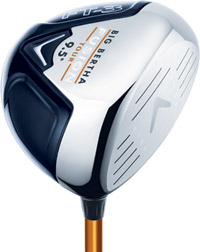 The standard and Tour FT-3 models have other differences from a construction standpoint. The Tour models have the weight tweaked slightly to help better golfers achieve a flatter ball flight, while the standard models have a lower center of gravity. The standard FT-3 comes with a proprietary “Fusion” version of the Aldila NVS shaft that is a little lighter and has different graphics than the stock Aldila NVS (which is the standard shaft in the Tour models). In addition, the Tour models are set up slightly open, while the standard models are a degree or two closed based on the loft.
The standard and Tour FT-3 models have other differences from a construction standpoint. The Tour models have the weight tweaked slightly to help better golfers achieve a flatter ball flight, while the standard models have a lower center of gravity. The standard FT-3 comes with a proprietary “Fusion” version of the Aldila NVS shaft that is a little lighter and has different graphics than the stock Aldila NVS (which is the standard shaft in the Tour models). In addition, the Tour models are set up slightly open, while the standard models are a degree or two closed based on the loft.
Regardless of the model or weighting inside, the construction of the FT-3 driver stands alone from anything else on the market. Unlike pear-shaped drivers like Titleist’s 905 series or the TaylorMade r7/r5 drivers, the FT-3 appears almost oblong (see address image above). The clubhead is very long from the face to the back, which allows designers to shift the center of gravity even farther away from the clubface for an even higher MOI. The face is also very deep but not very wide. Unlike wider-face drivers like the MACTEC NVG or Callaway’s own Big Bertha 454, the FT-3’s hitting area is nearly square. The deep-face design helps to launch shots on a higher trajectory with less spin.
A unique feature of the FT-3 that is instantly noticeable is the overall bottom-to-top thickness of the driver. Most drivers have a distinct seam around the perimeter of the clubhead, providing an angled delineation between the top and bottom sections of the driver. Not the FT-3. There is no seam area on this driver, just a smooth ribbon of carbon composite material from top to bottom without much taper. This gives the FT-3 a very sturdy appearance, as if a more standard-looking driver had lifted weights and bulked up a bit.
Esthetics
The FT-3 is a big upgrade over the ERC Fusion in this category. Last year’s model emphasized the two distinct materials of the clubhead, as the titanium cup face carried a dull gray finish while the black composite body had a clear finish that allowed you to see the carbon fibers woven together. The FT-3 is much more sleek, with a uniform wet black paint job over the top of the clubhead. At address, you can’t tell the club has two different sections fused together. The hitting area has a brushed finish and three rows of scorelines framing the smooth sweet spot, and the sides and bottom of the cup face sport a high-polish mirror finish.
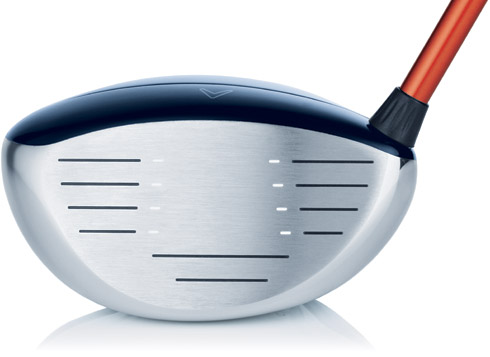
The tepid gray-black-yellow color scheme of the ERC Fusion is left behind for a shiny black and orange palette on the FT-3. The Fusion Aldila NVS shaft matches the fiery orange color used on the club’s sole, and orange and black dominate the huge FT-3 headcover as well. The orange is bright enough to grab your eye, but dark enough to not be distracting while you’re swinging the golf club. Callaway has carried these colors over to the new Fusion fairway woods, too.
The massive yellow chevron that sat in the middle of the ERC Fusion sole is gone, replaced by a smaller and more understated chevron. There are three dots on the heel of each club along with a designation of whether that clubhead has the Draw, Neutral or Fade weighting. In all, the FT-3 looks much better than the ERC Fusion. I actually liked the exposed carbon look of the older club, but every other design change is a major step forward in appearance.
There are some relatively minor cosmetic differences between the standard FT-3 and the Tour model. The standard model has the trademark Callaway chevron arrow-like alignment aid in the center of the clubhead’s crown. The Tour version dispenses of the chevron on the crown, which is a first for a club carrying the Big Bertha name. Instead, the FT-3 Tour has a chevron ghosted onto the center of the clubface, right where you want to hit the ball. The subtle chevron on the club’s face looks very durable, and makes it easier to tell which version of the FT-3 you’re looking at from a distance.
Performance
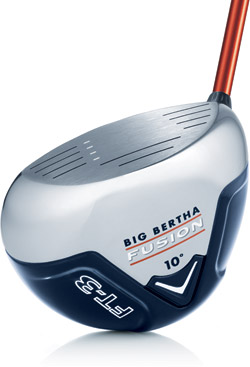 Cosmetic changes don’t mean much if the performance hasn’t been upgraded. Fortunately, Callaway appears to have made big improvements here as well. I tested a 10° standard FT-3 Neutral model with a stiff flex Fusion Aldila NVS shaft, and was able to have some other players use the club as well. We were all quite impressed.
Cosmetic changes don’t mean much if the performance hasn’t been upgraded. Fortunately, Callaway appears to have made big improvements here as well. I tested a 10° standard FT-3 Neutral model with a stiff flex Fusion Aldila NVS shaft, and was able to have some other players use the club as well. We were all quite impressed.
The most impressive thing about the FT-3 was the ball flight it created. The ball really jumps off the face and climbs to a very high trajectory. But instead of ballooning high and falling out of the sky, the ball gets up and stays up. I was amazed at the hang time my drives had with the FT-3, and the carry distance that went with it. The low-spin launch characteristics helped drives to power through the wind in spite of the high trajectory, and the ball really carried absurd amounts downwind. I played an early morning round after a heavy rain and made good contact on a downwind hole. I paced my drive off at 303 yards – and the ball mark was only one yard behind where the shot finished. Even with the wind, 302 in the air is a pretty good poke for me.
I won’t say that the FT-3 is the longest driver out there. But the other testers to try the driver side-by-side with their existing drivers were within five yards of their best drives with FT-3. This is perfectly acceptable when you factor in the amazing forgiveness we experienced when using the FT-3. Off-center hits start offline, but then correct themselves enough to stay in play on most holes. And misses don’t lose much distance, either. Basically, you can hit the ball just about anywhere on the face and get a playable drive out of it – and flushed shots are rewarded with that majestic trajectory and plenty of distance.
Using the FT-3 Neutral model, I was able to hit hard cuts and running draws without any trouble. The club didn’t impose a certain type of shot on any of the testers. We were able to hit our standard driver shots, from high power fades to bullet draws, without changing our swings. We just noticed more forgiveness and less lost distance on miss-hits. A nice combination, to be sure.
Sound has been a big issue with Callaway’s past composite drivers. The C4 produced a quite “thud,” and ERC Fusion had a low metal “clunk.” The FT-3 gives you a loud sound that I would describe as a “click.” It isn’t the high-pitched metallic sound of many drivers on the market today. But it is a positive, confident sound that matches the smooth feel you notice at impact. I doubt that the sound would keep anyone from buying this driver, especially after they launch a few drives with it.
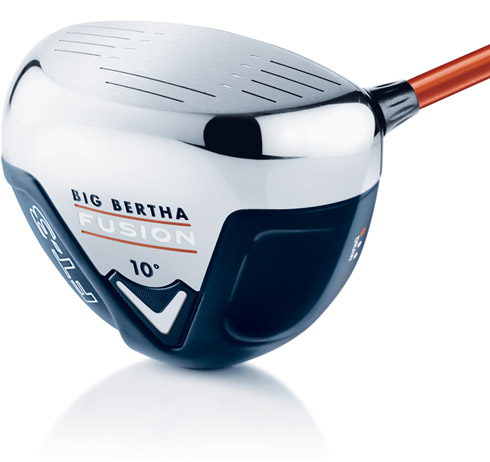
The Fusion Aldila NVS shaft was a good performer for my 105mph swing speed. A couple of testers with 110mph-plus swings found this 55-gram shaft to work well with their swings, as did a tester with a mid-90s swing speed. A player with a very fast tempo might benefit from a heavier shaft, and several custom options are available, including the Aldila NV, Grafalloy Blue and ProLaunch Blue, Fujikura Fit On! Six, Speeder and Vista Pro, and the Graphite Design YS-6 and YS-7.
Conclusion
For the first time since the ERC II five years ago, Callaway Golf has a driver that stands out from everything else in terms of design and performance. Given the huge array of lofts and weight positions, the FT-3 should appeal to nearly any type of golfer. The performance is outstanding, and it is a flat-out fun driver to hit. Launching a series of high, long drives with an FT-3 can definitely make a round of golf more fun. My second round with the FT-3 in my bag was my low round of the summer, and I improved it by three strokes the following round. It’s amazing how hitting the ball long and straight helps your score, huh?
Like other drivers with multiple weight configurations and shaft offerings, be sure to get fit by a qualified PGA Professional. You’ll be glad you did.
Specs
The Callaway Big Bertha Fusion FT-3 driver is available in standard and Tour models in a choice of Draw, Neutral and Fade configurations. The FT-3 Tour driver is available in right-hand only in 8.5° and 9.5° versions. The standard FT-3 is available in 9°, 10°, 11° and a High Trajectory 16° version for righties and 10° and 11° versions for lefties. All models are 460cc, and a wide variety of shafts are available. For complete specs, see callawaygolf.com or ft-3.com.
Thanks for that great review. I’m looking forward to trying a FT-3 out.
safe bred i hit 90 yards with this the other day. and well straight, but the centr dispersion isnt that good.
I was looking for a new driver over months and took a FT-3 onto my home course last week. Well, I’ve got a new driver! I’ve never ever hit all fairways with an unfamiliar test club but with the FT-3 I did. Great distance, 100% fairway hits, I’m in love. Sure, I must have had a good day too, but this driver is fabulous!
But does it work for us hackers who have that shot which turns from power fade to perplexingly ugly power slice? I would be interested in whether the draw model actually will help a high handicap player.
I’m an amatuer golfer with a +10 handicap on a good day, but have enjoyed playing for many years. As with many of us, I have relied and become comfortable with my irons but couldnt find that long and straight tee shot I was looking for to set me up for a good second shot. After looking around I believe the Callaway FT-3 will be a great improvement to my game, especially with the different configurations to the common flaws in your swing; mine being the slice. I found your review very helpful and assuring and am excited to go out and watch the ball fly. I have also taken advantage of Callaway’s deal of purchasing a Fusion driver and recieving a fairway wood free. I expect my game to better drastically and have more fun playing.
Just got an FT-3 Tour Edition 8.5 degrees, neutral, Aldila NV 65 Stiff (green) shaft from Callaway Pre-Owned. I used the shop by custom shaft option and was able to find just what I was looking for. Admittedly, I was a little nervous about buying a used club without hitting it, but the buy-back deal is very good, so I took the plunge – and picked up a ‘like new’ club that I could not see any evidence of it ever having been used for $270. I had hit 9.5 degree model a few times at the end of a demo day and liked it even though I was hitting moon shots. Scoping out shaft characteristics and thinking about the specs of my old Taylor Made 300Ti (8.5 with the Tour S-90 shaft and a head that came unglued on the practice tee before a tournament), the NV 65 had the characteristics I was after.
Frankly, I don’t know my swing speed and I’ve never used a launch monitor, but I know if a club feels right in my hands and the ball has the basic trajectory I’m after when I make a good swing. Can I hit it low? Can I hit it high? Can I work the ball a little? Check, check, check. Yes, the FT-3 is very solid, has a nice boring trajectory even when purposely hit higher, and is pretty forgiving. You can feel the higher kick point and low torque in the shaft at work. Yes, it is longer than my 300Ti, and with the control the NV 65 brings, perhaps straighter on lower-quality swings. One thing not commented on much is the way the club looks at address. Very square setup, but also one that has a face profile from the top similar to my 300Ti (somewhat deeper, but not much wider) – unlike the 905R, which is quite wide looking by comparison. Overall, the proportions make it look less like a melon on a stick than most 460cc drivers.
As for the sound, yes, it’s not pretty, but the tactile and auditory feedback is excellent, and nothing has sounded really good since my Tony Pena persimmon driver was stolen years ago anyway. It’s kind of like learning to drink beer: the first one doesn’t taste so great, but you grow the like it because of how drinking the stuff makes you feel. 😉 And no, I did not split every fairway with 350 yard drives.
Hi, I am going to get some fusion clubs and was wondering what the main differences are in the tour model and the standard model, other than the 1′ closed as opposed to .5′ open! Is it in anyway less forgiving? thanks in advance!
He was not kidding, I have been hitting Callaway irons for three years and my shots are crisp and straing, but when I hit my Cleveland Launcher off the tee things would tend to go sour. I changed nothing about my swing, used a 9’Draw Ft-3 and what a difference. Even when I knew my hips rotated too much, or my head pulled up slightly the ball hangs on. It is crazy, not to mention that with the Cleveland I could only max out at 260-275, NOw I average 300+. A great buy to shave points off your game.
Follow-up on FT-3 Tour Edition 8.5 degrees, neutral, Aldila NV 65 Stiff (green) shaft. This club keeps growing on me. I now trust it as much as my old 300Ti. The shaft choice has been a good one. At first its higher kick point than the Taylor Made Tour-S I had made the club seem a bit less alive in my hands, but the feel has returned over time – not a pole at all, but very stable feeling.
The clubhead continues to impress me. You can feel it when you are just the tiniest bit off-center – subtle, but it’s there. Certainly it’s very forgiving, but the thrill of knowing you’ve caught one flush is still there, along with feeback the tells you how much you missed the sweetspot by. I don’t mean the sweetspot they show in the ads, I mean the dime-sized, dead on, ‘on the screws’ (showing my age 😉 ) sweetspot. If you are a ‘player’, you’ll really appreciate this; if you’re not, be certain this club will make the best of your bad swings.
Have the tour 9.5 with NVS regular shaft. In a word, I HATE
this driver. Harder to hit than my 275cc Spalding Cannon I
bought in 1982. Smallest sweet spot I have ever encountered. I would reccommend only for tour pro’s.
3 handicap, Tour 9.5, fitted with a Grafalloy ProLaunch Blue shaft. Previously I had a Ping G5 9 degree that was just fine, however the sound was very high pitched and to me sounded rather weak. with this Tour model, I absolutely love the “clack” sound I get, and the shaft combination gives me a fantastic result: mid launch, penetrating ballflight, and I can work the ball enough. As far as distance goes, it’s really not that big of a deal, because when you can get it in the fairway its hard to complain, but I’ve gained 20 yards on average from the G5. I was in a tournament a couple of days ago and I walked off 4 drives; 327, 291, 318 and 332. this club is a monster. It feels as if you are smashing in the face of the driver when you hit it on the sweet spot. on setup the plain top without the chevron gives me confidence I’ve never had with the G5, or any of my previous drivers ever. the downside to this club is very minor. when hit on high on the face there is a small loss in distance, but misses on the bottom, hard heel and toe of the club result in little loss of accuracy. misses compared to the G5 are major: when I hit my miss (a block cut) the G5 would sail out of play, however the FT-3 keeps them in play, and for the most part in the fairway. A fantastic buy and a keeper. something truly astronomical is going to have to come out to pry this driver off of my cold dead body, thats for sure 😉
Anyone who can’t hit this FT-3 driver needs to find a different hobby! This is absolutely the most forgiving driver on the market, bar none! I have tried all 3 designs (draw, neutral, fade), and they all do EXACTLY what they are designed to do. My wife was fighting the “pulls”, so I gave her a 9.5° Tour ‘fade’ model, and all she’s managed to do is hit every fairway and add 15-25 yds over her Ping G2. She’s now consistantly shooting in the high 80’s low 90’s. Yes, technology is a good thing, and this driver has plenty of it. There’s no straighter driver, or one with a bigger sweet spot than this one. All I have to do now is tweek the shafts until I get the one that gives me the trajectory I want. I have a 9.5° Tour Neutral, and a 9.5° Tour Draw. GREAT drivers!!
high-teens handicap. Played with a Yonex driver for years – 20+ year old technology. With that driver best hits were 240 yards – generally drives were ~225, and if I missed the center of clubface by too much, it was ugly. Friend said I was costing myself 20-30 yards, at least, using outdated technology, and he tipped me on the FT3. Went to fitter, and he insisted I try 6 drivers on the monitor. The FT3 was clearly the choice-none of the other drivers even came close: 1. swing feel. 2. sound 3. 15 of 20 balls hit were on or very near sweet spot. 4. spin-rate way down vs. my old driver .
I bought the FT3, reg shaft ,neutral, 10deg and also 3,5 woods I liked their feel so much as well. On the course – HUGE difference – now driving it frequently 240-250yd. Best hits take it out 260-265 (1 or 2 drives/round). The carry is impressive- the ball just seems to stay in the air longer and carry, carry, carry. My tendency on my misses was to hit down too much, elevate too much and impart too much spin.
I almost never do that now. I am a believer in the FT3, and I can’t believe I suffered with old technology for so long. Golf is more fun, and I now think I have a chance at getting to a low-teens or single-digit (I’m optimistic) handicap.
I bought a standard draw FT-3 Fusion with a regular flex Aldila NV 65 Graphite shaft hoping to fix my horendous slice. The slice is still plagueing me and now I have a horendous draw as well . Mine has a regular stiffness shaft. I do have to say when I hit the driver well it is awesome! Far and true. I tried a draw Tour model after I ordered the FT-3 mentioned above (wish I had bought this one), it was uncanny!! I hit it straight and true a number of times, no slice no draw. The Tour, in my situation, is a great club. I could swing as hard and fast as I could possibly swing and still hit it straight. If you are trying to fix a slice, go for the Tour model with a stiff shaft.
I’ve had this driver for 2 and a half years now and I must say that its the best driver that i’ve ever hit, period. I’ve had some bad days on the course and still this club never really lets me down. I can push and pull of course but thats my swing, mis hits find the target, no doubt about that. I am now 17, and a single digit handicap and still use the exact same driver as I did years ago. The club isnt the only thing that i love though, callaway customer service is by far the BEST in the business. I’ve had 2 problems with the driver, one time the driver sounded alot different than my buddies and i called them up, replaced it with a question. another time there was some epoxy loose in the head and again, replaced without a second thought. They are incredible.
THANK YOU CALLAWAY for making such a fantastic club!
Just bought a Callaway FT-3 Tour Fusion for £47, it will arrive in 5 days, After reading all the above reviews I am seriously excited about getting down the range to have a blast with it.
Is £47 good money for 2 year old club ???
Just bought a Callaway FT-3 Tour Fusion neutral for USD79 WHICH the postage USD60, it will arrive in 5 days. I am Living in Brunei Darussalam. The Postage of my driver is too much, But Need ther Driver so much.
IF FEDEX can reduce their postage cost..I think Mr. Tiger Wood will only recieved USD5 million instead of USD10 million.
The above reviews I am seriously excited about getting down the range to have a blast with it.
I have Purchase Quite Lot of Drivers, KRANK Rage..Chili HoT Paper, Taylormade CGB, TM R7, Cobra, Titliest 909D2.
During my senior Tournement recently 22nd. Nov 2009, I Used Callaway X 460.. My T Off.. 250yd Centre of Fairways.. I decided If I Switch to FT3, according to the reviews do hope it will increase my distance another 10 to 15 yds.. The Result is 2nd in the tournmment.
I used several drivers to meet my swing motion and I have dramatically increased my distance and accuratecy off the tee. After using the Callaway FT-3 fusion my handicap remains low, thank you Callaway.